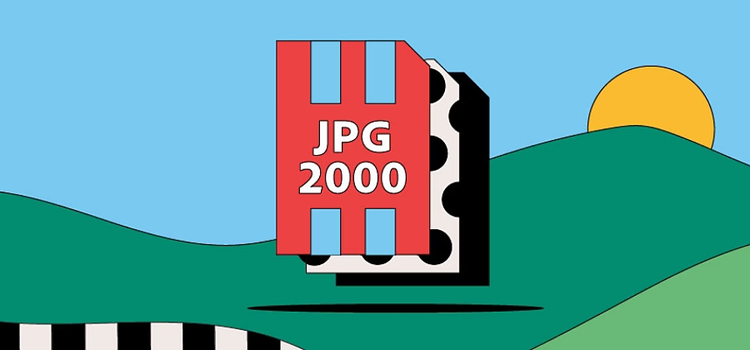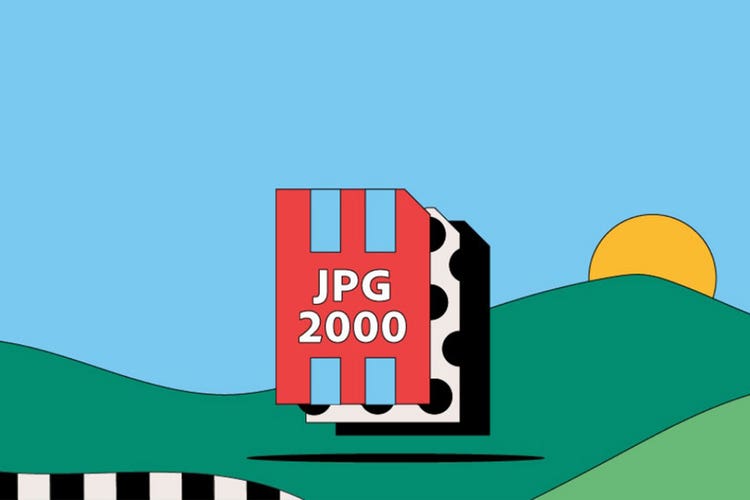FOTOGRAFIE
JPEG 2000-Dateien.
JPEG 2000 ist die verlustfreie Version des verlustbehafteten JPEG-Formats. Mit dem neueren JPEG 2000, das von der Joint Photographic Experts Group entwickelt wurde, wurden auch Systemfehler und das Problem schlechter Auflösungen behoben.
Trotz seiner Vorteile erreichte JPEG 2000 nicht die Beliebtheit, die sich die Entwicklerinnen und Entwickler erhofft hatten. Finde heraus, ob JPEG 2000 das richtige Dateiformat für dich ist und wie du es für dein nächstes Projekt einsetzen kannst.

Was ist eine JPEG 2000-Datei?
Die Joint Photographic Experts Group führte JPEG 2000 zur Jahrtausendwende als Update von JPEG ein. JPEG 2000 ist wie JPEG ein pixelbasiertes Rasterformat.
Im Vergleich zu JPEG bietet JPEG 2000 eine höhere Leistung und schärfere, detailreichere Bilder mit mehr Farbtiefe. JPEG 2000-Dateien können mit verlustfreier Kompression gespeichert werden, was bedeutet, dass bei der Komprimierung nur sehr wenige Bilddaten verloren gehen. JPEG 2000 unterstützt außerdem einen höheren dynamischen Bereich und ist weniger anfällig für Bit-Fehler. Der Nachteil ist, dass nicht alle Browser mit dem JPEG 2000-Format kompatibel sind. Tatsächlich ist Safari der einzige gängige Browser, über den sich JPEG 2000-Dateien öffnen lassen.
JPEG 2000-Dateien haben folgende Dateierweiterungen:
- .JP2
- .JPX
- .J2K
- .J2C
- .JPF
Geschichtlicher Hintergrund.
Die Joint Photographic Experts Group führte JPEG 2000 als JPEG der nächsten Generation ein. Das Format versprach mehr Leistung und eine höhere Bildqualität, konnte sich aber niemals durchsetzen.
Dafür gibt es verschiedene Gründe. JPEG 2000 ist nicht abwärtskompatibel. Das Format funktionierte also nur mit neuester Technologie. Hinzu kommt, dass der durchschnittliche Arbeitsspeicher eines Computers zum Zeitpunkt der Einführung nur bei 64 MB lag. Dies reichte bei Weitem nicht aus, um die Dateien reibungslos zu verarbeiten.
Trotz seiner zahlreichen Vorteile geriet JPEG 2000 schnell in Vergessenheit.
Bildgebende Diagnostik.
JPEG 2000-Dateien unterstützen HDR, höhere Auflösung und Transparenz. Im Medizinbereich werden sie deshalb für die Kernspin- und Computertomografie sowie Röntgenaufnahmen verwendet.
Digitalkino.
Motion JPEG 2000 basiert auf JPEG 2000 für die Videokompression. Der hohe dynamische Bereich, die bessere Auflösung und die zusätzlichen Farbräume machen es zu einem wichtigen Dateiformat für das Digitalkino. Das Format wurde 2004 zum Codierungsstandard für Video.
Was sind die Vor- und Nachteile von JPEG 2000-Dateien?
Bevor du mit JPEG 2000 arbeitest, solltest du die Vor- und Nachteile dieses Formats kennen.
Vorteile von JPEG 2000-Dateien.
- JPEG 2000 unterstützt sowohl verlustfreie als auch verlustbehaftete Komprimierung. Du hast also die Wahl, ob du Dateien als RAW-Bilder oder in einem austauschbaren Dateiformat speicherst.
- JPEG 2000 unterstützt im Gegensatz zu seinem Vorgängerformat größere Dateien ohne Tiling (optionale Zerlegung der Bilder in Blöcke).
- Das JPEG 2000-Format lässt sich einfach skalieren, sodass Auflösung und Dateigröße besser aufeinander abgestimmt werden können.
- Der wichtigste Vorteil gegenüber JPEG ist die geringere Anfälligkeit für Bit-Fehler.
Nachteile von JPEG 2000-Dateien.
- Viele Webbrowser und Websites, auf denen Fotos geteilt werden, bieten keine Unterstützung für JPEG 2000. JPEG 2000 wird sehr selten außerhalb der oben genannten Bereiche eingesetzt.
- Aufgrund der fehlenden Abwärtskompatibilität zum JPEG-Originalformat müssen Anwenderinnen und Anwender in der Lage sein, die Codierung in einem Standard vorzunehmen, der nicht dem üblichen Standard für Bilder entspricht.
- JPEG 2000-Codecs beanspruchen viel Arbeitsspeicher, was die Performance und Komprimierung verlangsamen kann. Dieses Dateiformat funktioniert also am besten auf Computern mit umfangreichem Arbeitsspeicher.
Wie öffne ich eine JPEG 2000-Datei?
JPEG 2000 ist mit mehreren Bildbearbeitungs-Programmen kompatibel, zum Beispiel Adobe Photoshop. Um eine JP2-Datei zu öffnen, starte einfach die neueste Version von Photoshop und wähle die JP2-Datei auf deinem Computer aus.
Safari ist der einzige Webbrowser, der JPEG 2000 unterstützt. Um dieses Format in einem anderen Browser wie Chrome oder Edge zu öffnen, musst du die JP2-Datei zunächst in ein anderes Format konvertieren.
Wie erstelle und bearbeite ich eine JPEG 2000-Datei?
So erstellst du eine JPEG 2000-Datei mit Adobe Photoshop:
1. Öffne eine vorhandene Bilddatei in Photoshop, und klicke auf „Speichern unter“.
2. Wähle im Menü „Format“ die Option „JPEG 2000“.
3. Aktiviere bei Aufforderung das entsprechende Kontrollkästchen, um die Datei verlustfrei oder verlustbehaftet zu speichern. Bei der verlustfreien Komprimierung entsteht ein größeres (aber hochwertigeres) Bild.
4. Wenn du die verlustbehaftete Komprimierung auswählst, kannst du den Grad der Komprimierung mithilfe des Reglers und der Vorschau anpassen.
5. Speichere deine neue JPEG 2000-Datei am gewünschten Speicherort.
